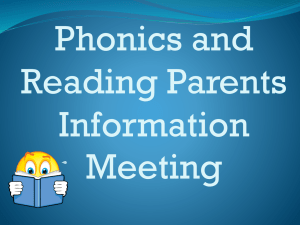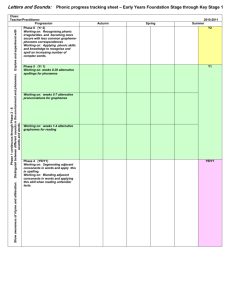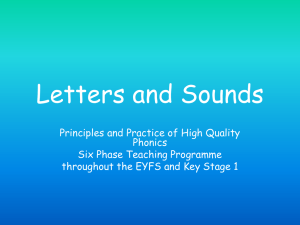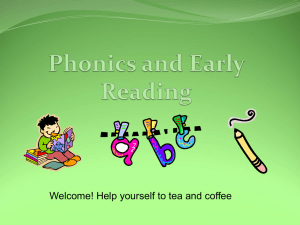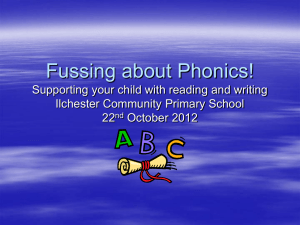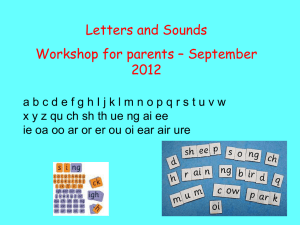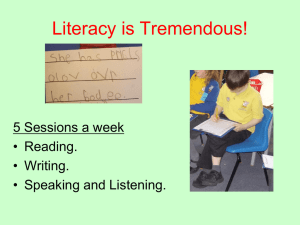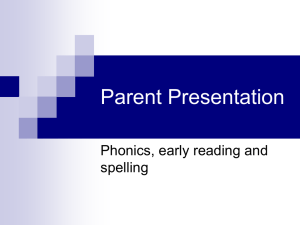slide presentation
advertisement
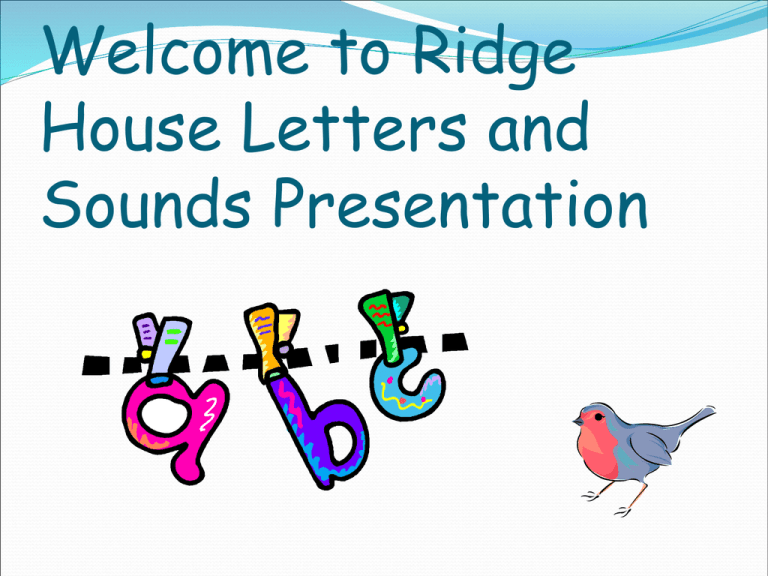
Welcome to Ridge House Letters and Sounds Presentation 5 Basic Skills 1. Learning letter sound 2. Letter formation 3. Blending 4. Identifying sounds 5. Tricky words Why phonics? The aim is to secure essential phonic knowledge and skills so that children progress quickly to independent reading and writing Reading and writing are like a code, phonics is teaching the child to crack the code Gives us the skills of blending for reading and segmenting for spelling. Blending is recognising the letter sounds in a written word, for example c-u-p, and merging or synthesising them in the order in which they are written to pronounce the word ‘cup’ Segmenting is identifying the individual sounds in a spoken word (e.g. ‘him’ = h – i - m) and writing down letters/grapheme for each sound to form the word. Digraph A digraph contains two letters and it makes one sound oa ai ee ie for these digraphs we say ‘when two vowels go walking the first one does the talking’, so you say the letter name to make the sound Other digraphs oo ar or er oi sh ck th ll Reading and Writing For reading: Phonemes/sounds associated with particular graphemes/letters are pronounced in isolation and blended together. For writing: Words are segmented into phonemes orally, and a grapheme written to represent each phoneme Phase one In developing their phonological awareness children will improve their ability to distinguish between sounds and to speak clearly and audibly with confidence and control. Through speaking and listening activities, children will develop their language structures and increase their vocabulary. Phase One outcomes Explore and experiment with sounds and words Listen attentively Show a growing awareness and appreciation of rhyme, rhythm and alliteration Speak clearly and audibly with confidence and control Distinguish between different sounds in words Develop awareness of the differences between phonemes Phase 2 To introduce grapheme-phoneme (letter-sound) correspondences (video clip) Children know that words are constructed from phonemes and that phonemes are represented by graphemes They have knowledge of a small selection of common consonants and vowels. They blend them together in reading simple CVC words and segment them to support spelling. Tricky words Some words cannot be sounded out or spelt correctly by listening for the sounds in them. These are called ‘tricky words’ and have to be learnt. Examples of tricky words: the, to, I, no, go, into, he, she, me, we. The best way of learning these are flash cards and matching games and finding words in books, magazines, comics etc. High frequency words The National Literacy Strategy "Framework for Teaching" identifies an essential set of words that your child needs to learn “even to tackle very simple texts”. According to the NLS; “these words play an important part in holding together the general coherence of texts and teachers are encouraged to get their pupils to recognise them as soon as possible so they can get pace and accuracy into their reading at an early stage. Some of these words have irregular or difficult spellings and, because they often play an important grammatical part, they are hard to predict from the surrounding text.” Below are listed the 45 high frequency words that your child will be expected to read on sight, in and out of context, by the end of their first year in school I go come went up you day was Look are the of we this dog me Like going big she and they my see On away mum it at play no yes For a dad can he am all Is cat get said to in Phase 3 To teach children one grapheme for each of the 44 phonemes in order to read and spell simple regular words. Phase Three outcomes Children link sounds to letters, naming and sounding the letters of the alphabet. They recognise letter shapes and say a sound for each. They hear and say sounds in the order in which they occur in the word, They read simple words by sounding out and blending the phonemes all through the word from left to right. They recognise common digraphs and read some high frequency words Phase four To teach children to read and spell words containing adjacent consonants. Phase four outcomes Children are able to blend and segment adjacent consonants in words They apply this skill when reading unfamiliar texts and in spelling Phase 5 Teaching children to recognise and use alternative ways of pronouncing the graphemes and spelling the phonemes already taught. Phase 5 outcomes Children will: use alternative ways of pronouncing the graphemes and spelling the phonemes corresponding to long vowel phonemes. identify the constituent parts of two-syllable and three-syllable words and be able to read and spell phonically decodable two-syllable and three-syllable words. recognise an increasing number of high frequency words automatically. apply phonic knowledge and skills as the prime approach in reading and spelling when the words are unfamiliar and not completely decodable. Phase 6 Teaching children to develop their skill and automaticity in reading and spelling, creating ever-increasing capacity to attend to reading for meaning. Phase six outcomes Children will: Apply their phonics skills and knowledge to recognise and spell an increasing number of complex words. Read an increasing number of high and medium frequency words independently and automatically. Summary A phoneme is the smallest unit of sound in a word, a phoneme may be represented by 1, 2, 3 or 4 letters e.g. t, ai, igh, eigh. A syllable is a word or part of a word that contains one vowel sound. A grapheme is the letter(s) representing a phoneme. It is the written representation of a sound which may consist of 1 or more letters. E.g. the phoneme ‘s’ can be represented by the grapheme s (sun), se (mouse), c (city), sc or ce (science) Summary continued Digraph is two letters which make one sound. A consonant digraph contains two consonants e.g. sh, ck, th, ll. A vowel digraph contains at least one vowel ai, ee, ar, oy Split digraph, is a digraph in which the two letters are not adjacent e.g. make Trigraph, three letters, which make one sound igh, dge Oral blending-hearing a series of spoken sounds & merging them together to make a spoken word (no text is used) e.g. when a teacher calls out ‘b-u-s’ the children say bus. This skill is usually taught before blending and reading printed words Blending-recognising the letter sounds in a written word, e.g. c-up, and merging or synthesising them in the order in which they are written to pronounce the word ‘cup’ Segmenting-identifying the individual sounds in a spoken word e.g. h-i-m and writing down or manipulating letters for each sound to form the word ‘him’ Useful websites & resources www.jollylearning.co.uk www.phonicsplay.co.uk www.familylearning.org.uk www.education.gov.uk search letters and sounds www.letters-and-sounds.com Magnetic letters, Flash cards, Please ask a member of staff if you have any questions or want to borrow resources

